Invest in social networks when it isn’t an emergency

 Almost 12 months ago Greater Manchester Police in England carried out a 24 hour ‘tweetathon’ to highlight what the police were faced with on a daily basis. At that time we didn’t realise how crucial that work was going to be to the future communication the Force carries out.
Almost 12 months ago Greater Manchester Police in England carried out a 24 hour ‘tweetathon’ to highlight what the police were faced with on a daily basis. At that time we didn’t realise how crucial that work was going to be to the future communication the Force carries out.
The work in October 2010 signified a change in the way the Force aimed to communicate and engage with communities. It was a move from paid for advertising to greater use of social media and traditional media relations.
When trouble started to erupt on the streets of Manchester and Salford in early August the 10 months of hard work to develop communication through social networks started to pay off. We had already managed to have a healthy 23,000 Twitter followers, and had 90 per cent of our neighbourhood policing teams Tweeting to their local communities. The photographic networking site Flickr also was attracting thousands of visitors.
From the start the communication plan was developed to ensure it was fully integrated from traditional through to social media management and this became a key element of the policing operation. The Force Twitter feed was used in the early stages to discount rumour and speculation when it could, and to encourage people to report any concerns they had. This wasn’t used just to push information out, we used it to start a conversation with the people living in Greater Manchester and they took the opportunity.
Once disturbances were taking place it was clear there was going to be a huge police investigation to identify those involved. Within six hours of the trouble starting, we had established a ‘most wanted’ Flickr site, Facebook page, were tweeting updates, had put press conferences on YouTube and all this was accessible through the Force Internet site.
The key was to provide people with an easy way of sending photographs and footage in to the Force of the disturbances which would be able to help the investigation team. But also to be able to quickly push out images of those involved circulate them to the local media and also highlight them through social networks. Essential to make all this happen was integrating all the elements of social media that we used.
We had tremendous feedback with overwhelming support from people both for the policing response and for the conversations we were having through social networks. These messages were circulated through our internal Intranet and had a huge boost on morale of officers and staff working long hours. After just a few days we had reached 101,000 followers on Twitter, had more than 7,000 friends on the Facebook page and the ‘most wanted’ Flickr site had well over 1m hits.
Using social networks was critical to being able to support the investigation and gauge the mood of communities. The conversations were essential to the development of our communication and the feedback people gave us will help refine our use of social networks. All the hard work and effort to use social networks to engage with people really was and is essential. The key to all law enforcement agencies is to learn about social networks and what they can do when you have time and streets are not burning. You can’t hope to start to learn about social networks when the bullets are flying.
 Amanda has more than 10 years experience in senior communications roles within the police service and is currently responsible for the Corporate Communications function at Greater Manchester Police.
Amanda has more than 10 years experience in senior communications roles within the police service and is currently responsible for the Corporate Communications function at Greater Manchester Police.
Initially, trained as a journalist Amanda worked on local newspapers throughout the North
West of England before moving into public relations working for a number of public sector organisations.
She has led the communication team at Greater Manchester Police during some challenging times including the death of the former Chief Constable and numerous counter terrorism investigations. Amanda has been part of the Force’s work to improve community engagement and communication. She was also responsible for the development of the GMP Twitter Day activity in October 2010 where the Force published details of all calls received in a 24 hour period.



Is Amanda aware of the efforts of the Queensland Police during the emergency in northern Australia from late 2010 to early 2011?
Their use of Twitter and Facebook for emergency management was exceptional – from six months before the emergencies and right through into their ongoing use of social media.